This focus idea is explored through:
Contrasting student and scientific views
Student everyday experiences
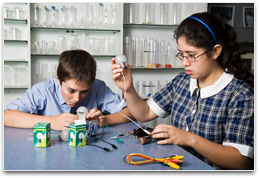 Students have plenty of experience using everyday household appliances that rely on electric circuits for their operation ( torches, mobile phones, iPods). They very likely have developed a sense that you need a battery or power switch to be turned on to make things ‘work’, and that batteries can go ‘flat’. They tend to think of electric circuits as involving something they call ‘current’ or ‘energy’ or ‘electricity’ or ‘voltage’, all labels which they often use interchangeably. This is unsurprising given that all these labels are frequently used in everyday language with unclear meaning. Whichever label students use, they are likely to see electric circuits as involving ‘flow’ and something being ‘stored’, ‘used up’, or both. Some everyday language, for example about ‘charging batteries,’ may also be a source of conceptual confusion for students.
Students have plenty of experience using everyday household appliances that rely on electric circuits for their operation ( torches, mobile phones, iPods). They very likely have developed a sense that you need a battery or power switch to be turned on to make things ‘work’, and that batteries can go ‘flat’. They tend to think of electric circuits as involving something they call ‘current’ or ‘energy’ or ‘electricity’ or ‘voltage’, all labels which they often use interchangeably. This is unsurprising given that all these labels are frequently used in everyday language with unclear meaning. Whichever label students use, they are likely to see electric circuits as involving ‘flow’ and something being ‘stored’, ‘used up’, or both. Some everyday language, for example about ‘charging batteries,’ may also be a source of conceptual confusion for students.
Specifically, students often see current as being the same as voltage, and think current can be stored in a battery, and that current may be used up or transformed into a form of energy, like light or heat.
There are four models that are commonly used by students to explain the behaviour of a simple circuit containing a battery and a light bulb. These have been described by researchers as:
Specifically, students often see current as being the same as voltage, and think current can be stored in a battery, and that current may be used up or transformed into a form of energy, like light or heat.
There are four models that are commonly used by students to explain the behaviour of a simple circuit containing a battery and a light bulb. These have been described by researchers as:
| Four simple circuit models |
|---|
-
‘the unipolar model’ – the view that only one wire is actually needed between the battery and the light bulb for there to be a current in the circuit.
|
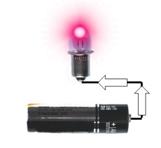
|
-
‘the clashing currents model’ – the view that current ‘flows’ from both terminals of the battery and ‘clashes’ in the light bulb.
|
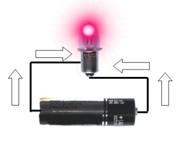
|
-
‘the current consumed model’ – the view that current is ‘used up’ as it ‘goes around’ the circuit so the current ‘flowing towards’ the light bulb is greater than the current ‘flowing away’ from it back to the battery.
|
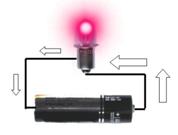
|
-
‘the scientific model’ – the view that the current is the same in both wires.
|
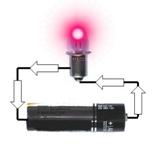
|
Students’ everyday experiences with electric circuits often lead to confused thinking. Students who are aware that you may get an electric shock if you touch the terminals of an empty household light socket if the switch is on, therefore sometimes believe that there is a current in the socket, regardless of whether or not they are touching it. (Likewise they may believe that there is a current in any wires connected to a battery or power-point, regardless of whether the switch is closed.)
Some students think that the plastic insulation on wires used in electric circuits contains and directs the electric current in the same way that water pipes hold and control the flow of water.
Research: Osborne (1980), Osborne & Freyberg (1985), Shipstone (1985), Shipstone & Gunstone (1985), White & Gunstone (1980)
Scientific view
The term ‘electricity’ (like ‘chemistry’) refers to an area of science.
Models play an important part in helping us to understand things we cannot see and so are particularly helpful when trying to make sense of electrical circuits. Models are valued both for their explanatory capacity and their predictive ability. Models however, also have limitations.
The model used for electric circuits by scientists today makes use of the idea that all substances contain electrically charged particles (see the focus idea
Macroscopic versus microscopic properties). According to this model, electrical conductors, such as metals, contain charged particles that can be moved from atom to atom relatively easily whereas in poor conductors, insulators like ceramics, charged particles are much harder to move.
In the scientific model, electric current is the overall movement of charged particles in one direction. The cause of this movement is an energy source like a battery, which pushes the charged particles. The charged particles can move only when there is a complete conducting pathway (called a ‘circuit’ or ‘loop’) from one terminal of the battery to the other.
A simple electric circuit can consist of a battery (or other energy source), a light bulb (or other device that uses energy), and conducting wires that connect the two terminals of the battery to the two ends of the light bulb. In the scientific model for this kind of simple circuit, the moving charged particles, which are already present in the wires and in the light bulb filament, are electrons.
Electrons are negatively charged. The battery pushes the electrons in the circuit away from its negative terminal and pulls them towards the positive terminal (see the focus idea
Electrostatics – a non contact force). Any individual electron only moves a short distance. (These ideas are further elaborated in the focus idea Making sense of voltage). While the actual direction of the electron movement is from the negative to the positive terminals of the battery, for historical reasons it is usual to describe the direction of the current as being from the positive to the negative terminal (the so-called ‘conventional current’).
The energy of a battery is stored as chemical energy (see the focus idea Energy transformations). When it is connected to a complete circuit, electrons move and energy is transferred from the battery to the components of the circuit. Most energy is transferred to the light globe (or other energy user) where it is transformed to heat and light or some other form of energy (such as sound in iPods). A very small amount is transformed into heat in the connecting wires.
The voltage of a battery tells us how much energy it provides to the circuit components. It also tells us something about how hard a battery pushes the electrons in a circuit: the greater the voltage, the greater is the push (see the focus idea
Using energy).
Critical teaching ideas
- An electric current is the overall movement of charged particles in one direction.
- To obtain an electric current, there needs to be a continuous circuit from one terminal of a battery to the other.
- An electric current in a circuit transfers energy from the battery to the circuit components. No current is ‘used up’ in this process.
- In most circuits, the moving charged particles are negatively charged electrons that are always present in the wires and other components of the circuit.
- The battery pushes the electrons in a circuit.
Research: Loughran, Berry & Mulhall (2006)
Quantitative teaching approaches (e.g. using Ohm’s law) can impede the development of conceptual understanding and are best avoided at this level.
The language used by teachers is important. The use of the word ‘electricity’ should be limited because its meaning is ambiguous. Speaking about current ‘flowing’ instead of charged particles moving can reinforce the incorrect notion that current is the same as electric charge; as ‘charge’ is a property of substances, like mass, it is better to refer to ‘charged particles’ than to ‘charges’.
 The focus idea
Introducing Scientific Language provides further information on developing scientific language with students.
The focus idea
Introducing Scientific Language provides further information on developing scientific language with students.
The use of models, metaphors and analogies is vital in developing students’ understanding of electric circuits because to explain what we observe in a circuit (e.g. the lighting of a bulb) involves using science ideas about things we cannot see, such as energy and electrons. As all models/metaphors/analogies have their limitations, it is important to use a variety of them. It is equally important to be clear about the similarities and differences between any model/metaphor/analogy used and the phenomenon being considered. A common limitation of physical models (including those below) is that they imply any given electron travels all the way around a circuit.
 Explore the relationships between ideas about electricity and the advantages and limitations of models in the
Concept Development Maps – Electricity & Magnetism and Models
Explore the relationships between ideas about electricity and the advantages and limitations of models in the
Concept Development Maps – Electricity & Magnetism and Models
Some useful models and analogies to use are:
-
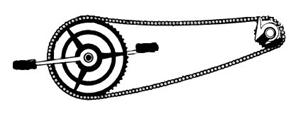 the bicycle chain analogy - this is helpful for developing the idea of energy flow, for distinguishing this energy flow from current, and for demonstrating the constancy of current in a given circuit. The motion of a bicycle chain is analogous to current in a complete circuit. The moving chain transfers energy from the pedal (i.e. ‘the battery’) to the back wheel (i.e. ‘the circuit components’) where energy is transformed. This model has only limited usefulness and requires the student to recognise that the back wheel is the component performing the energy transformation.
the bicycle chain analogy - this is helpful for developing the idea of energy flow, for distinguishing this energy flow from current, and for demonstrating the constancy of current in a given circuit. The motion of a bicycle chain is analogous to current in a complete circuit. The moving chain transfers energy from the pedal (i.e. ‘the battery’) to the back wheel (i.e. ‘the circuit components’) where energy is transformed. This model has only limited usefulness and requires the student to recognise that the back wheel is the component performing the energy transformation.
- the jelly bean model - this is helpful for developing the idea that the movement of electrons in a circuit is accompanied by a transfer of energy. Students role play ‘electrons’ in a circuit. They each collect a fixed number of jelly beans representing energy as they pass ‘the battery’ and give up this ‘energy’ as they reach/pass through ‘the light bulb’. These student ‘electrons’ then return to the ‘battery’ for more ‘energy’ which involves getting more jelly beans.
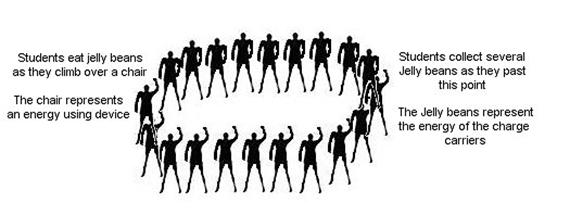
Another description of this type of activity is presented in the PEEL vignette
The Jelly Bean Role Play. This model can be very powerful but an important limitation is its representation of energy as a substance rather than as an invented human construct.
-
the rope model - this model is helpful for explaining why heating occurs in an electric circuit. Students form a circle and loosely hold a continuous loop of thin rope horizontally. One student acts as a ‘battery’ and pulls the rope so that it slides through the hands of the other students, ‘the circuit components’. The students can feel their fingers getting hotter as energy is transformed when the rope is pulled by the student battery
 For more information on developing ideas about energy, see the focus idea
Using energy.
For more information on developing ideas about energy, see the focus idea
Using energy.
-
the water circuit model - this is frequently used in text books, and at first glance appears to be a model that students can easily relate to; however, it is important that teachers are aware of its limitations.
This model uses a pump to represent the battery, a turbine to represent the light bulb, and water pipes to represent connecting wires. It is important to point out to students that this water circuit is actually different to the domestic water supply, because they may otherwise draw on their everyday experiences and incorrectly conclude for example, that electric current can leak out of circuit wires in the same manner that water can leak out of pipes.
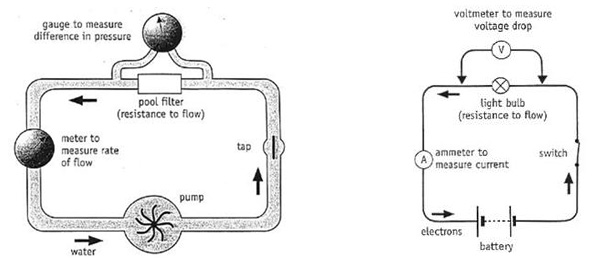
Research: Loughran, Berry & Mulhall (2006)
Teaching activities
Open discussion via a shared experience
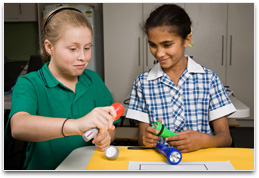 A POE (Predict-Observe-Explain) activity is a useful way of opening discussion. Give students a battery, torch light bulb (or other bulb with a filament) and some connecting wire. Ask them to predict how the circuit should be connected so the bulb lights up. Note: do NOT provide a bulb holder. This should provoke discussion about the need for a complete loop for current, and about the path of the current in the light bulb. This activity can be extended by encouraging students to use other materials instead of wires.
A POE (Predict-Observe-Explain) activity is a useful way of opening discussion. Give students a battery, torch light bulb (or other bulb with a filament) and some connecting wire. Ask them to predict how the circuit should be connected so the bulb lights up. Note: do NOT provide a bulb holder. This should provoke discussion about the need for a complete loop for current, and about the path of the current in the light bulb. This activity can be extended by encouraging students to use other materials instead of wires.
Challenge some existing ideas
A number of POEs (Predict-Observe-Explain) can be constructed by changing elements of an existing circuit and asking students for a prediction and their justification of this prediction. For example, ask students to predict changes that may occur in the brightness of a light bulb when it is connected to batteries with different voltages.
Clarify and consolidate ideas for/by communication to others
Ask students to explore the models and analogies for electric circuits presented above. Students should assess each model for its usefulness in clarifying ideas about electric circuits. Students should also be encouraged to identify the limitations of the models.
Focus students’ attention on overlooked detail
Ask students to explore the workings of a torch and draw a picture to show the path of the current when the switch is closed. Students should discuss or write about what they think is happening.
Encourage students to identify phenomena not explained by the (currently presented) scientific model or idea
Ask students to list the features of an electric circuit that are explained by a particular model/metaphor/analogy and the features that are not.
Promote reflection and clarification of existing ideas
Ask students to draw a concept map using the terms such as ‘battery’, ‘electrons’, ‘energy’, ‘connecting wires’, ‘light bulb’, ‘electric current’.